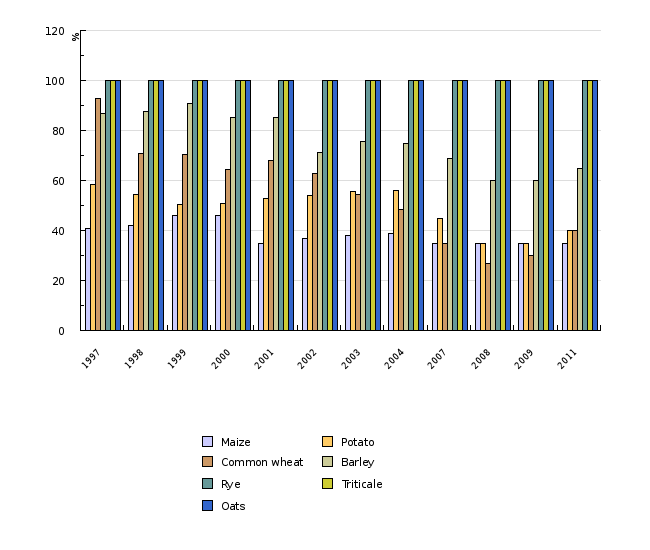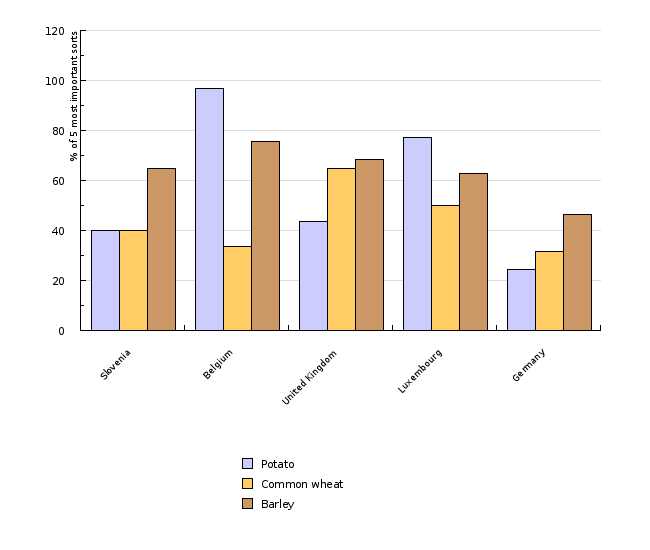[KM15] Genetic diversity - agriculture plants

Key message

The share of five most dominant varieties for each species of agricultural plants prevails in the majority of them, with the exception of maize, common wheat and potato. The total number of varieties in production for the stated three groups of agricultural plants from 2008 has declined.
Charts
Phytosanitary Administration of the Republic of Slovenia, 2009.
| 1990 | 1997 | 1998 | 1999 | 2000 | 2001 | 2002 | 2003 | 2004 | 2008 | ||
|---|---|---|---|---|---|---|---|---|---|---|---|
| Stubble cereals (common wheat) | number of sorts | np | 108 | 108 | 129 | 126 | 116 | 135 | 135 | 136 | 136 |
| Root crops – potato | number of sorts | np | 50 | 50 | 62 | 58 | 61 | 60 | 60 | 60 | 58 |
| Root crops – sugar beet | number of sorts | np | 21 | 21 | 20 | 20 | 21 | 18 | 18 | 18 | 13 |
| Maize | number of sorts | 460 | 111 | 111 | 133 | 156 | 157 | 184 | 184 | 189 | 234 |
| Fodder crops - grass | number of sorts | np | 66 | 66 | 75 | 78 | 75 | 76 | 76 | 69 | 66 |
| Fodder crops - grass (decorative) | number of sorts | np | 34 | 34 | 44 | 45 | 46 | 50 | 50 | 49 | 53 |
| Fodder crops – legume crops | number of sorts | np | 48 | 48 | 49 | 46 | 40 | 42 | 42 | 41 | 66 |
| Fodder crops – other fodder crops (incl. grain legumes, vetch and green manure plants) | number of sorts | np | 62 | 62 | 71 | 65 | 56 | 60 | 60 | 50 | 43 |
| Industrial plants (excl. sugar beet) – oil plants | number of sorts | np | 37 | 37 | 39 | 34 | 34 | 30 | 30 | 22 | 24 |
| Industrial plants (excl. sugar beet) – fibre crops | number of sorts | np | 8 | 8 | 8 | 9 | 10 | 10 | 10 | 9 | 9 |
| Industrial plants (excl. sugar beet) – hops | number of sorts | np | 12 | 12 | 13 | 13 | 13 | 14 | 14 | 14 | 14 |
| Industrial plants (excl. sugar beet) - other | number of sorts | np | 10 | 10 | 10 | 6 | 3 | 3 | 3 | 3 | 1 |
| 2009 | 2011 | ||||||||||
| Stubble cereals (common wheat) | number of sorts | 59 | 48 | ||||||||
| Root crops – potato | number of sorts | 59 | 62 | ||||||||
| Root crops – sugar beet | number of sorts | 5 | 5 | ||||||||
| Maize | number of sorts | 250 | 150 | ||||||||
| Fodder crops - grass | number of sorts | 21 | 21 | ||||||||
| Fodder crops - grass (decorative) | number of sorts | 0 | 0 | ||||||||
| Fodder crops – legume crops | number of sorts | 12 | 12 | ||||||||
| Fodder crops – other fodder crops (incl. grain legumes, vetch and green manure plants) | number of sorts | 9 | 11 | ||||||||
| Industrial plants (excl. sugar beet) – oil plants | number of sorts | 7 | 7 | ||||||||
| Industrial plants (excl. sugar beet) – fibre crops | number of sorts | 0 | 0 | ||||||||
| Industrial plants (excl. sugar beet) – hops | number of sorts | 15 | 15 | ||||||||
| Industrial plants (excl. sugar beet) - other | number of sorts | 0 | 0 |
Phytosanitary Administration of the Republic of Slovenia, 2011.
| 1997 | 1998 | 1999 | 2000 | 2001 | 2002 | 2003 | 2004 | 2007 | 2008 | ||
|---|---|---|---|---|---|---|---|---|---|---|---|
| Maize | % | 41 | 42 | 46 | 46 | 35 | 37 | 38 | 39 | 35 | 35 |
| Potato | % | 58.4 | 54.5 | 50.6 | 50.8 | 52.9 | 54.1 | 55.5 | 55.9 | 45 | 35 |
| Common wheat | % | 93 | 70.9 | 70.6 | 64.4 | 68 | 62.7 | 54.5 | 48.6 | 35 | 27 |
| Barley | % | 87 | 87.6 | 90.9 | 85.2 | 85.4 | 71.1 | 75.7 | 75 | 69 | 60 |
| Rye | % | 100 | 100 | 100 | 100 | 100 | 100 | 100 | 100 | 100 | 100 |
| Triticale | % | 100 | 100 | 100 | 100 | 100 | 100 | 100 | 100 | 100 | 100 |
| Oats | % | 100 | 100 | 100 | 100 | 100 | 100 | 100 | 100 | 100 | 100 |
| 2009 | 2011 | ||||||||||
| Maize | % | 35 | 35 | ||||||||
| Potato | % | 35 | 40 | ||||||||
| Common wheat | % | 30 | 40 | ||||||||
| Barley | % | 60 | 65 | ||||||||
| Rye | % | 100 | 100 | ||||||||
| Triticale | % | 100 | 100 | ||||||||
| Oats | % | 100 | 100 |
Phytosanitary Administration of the Republic of Slovenia, 2011; EuroSemStats, 2002.
| Slovenia | Belgium | United Kingdom | Luxembourg | Germany | ||
|---|---|---|---|---|---|---|
| Potato | % | 40 | 96.68 | 43.64 | 77.35 | 24.4 |
| Common wheat | % | 40 | 33.68 | 64.66 | 50.09 | 31.45 |
| Barley | % | 65 | 75.55 | 68.42 | 62.77 | 46.47 |
Goals
- maintaining as high as possible biological diversity and diversity of varieties in plant production, which is the basis for food production, and preserving landscape variety, the source of income for survival on farms and is part of natural and cultural heritage.











